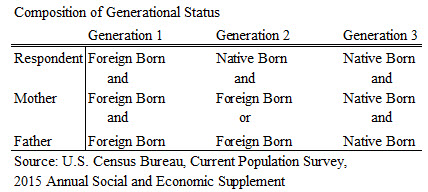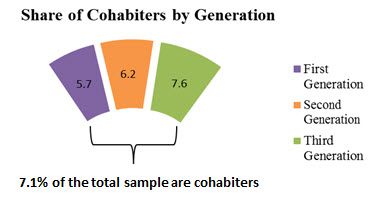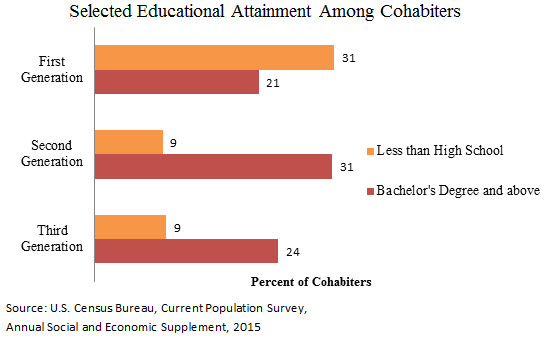Characteristics of Cohabiters and Their Generational Status
Characteristics of Cohabiters and Their Generational Status
Most adults in the United States have lived with a boyfriend, girlfriend or partner at some point in their lives. Specifically, we have seen an increase in the number of cohabiting [PDF <1.0 MB] couples over the last 20 years. However, much less is known about cohabiters who are either foreign-born or who have foreign-born parents.
I use the U.S. Census Bureau’s Current Population Survey data to examine how the place of birth of an individual and their parents are related to cohabitation and demographic differences of cohabiters by nativity. The Current Population Survey is a rich resource for data on the nativity of individuals and their parents since it includes not only data on nativity but also data on year of entry.
Here, generational status refers to three distinct groups shown in Table 1. A respondent who is foreign born with foreign-born parents is considered first generation. A native-born respondent with at least one foreign-born parent is second generation. Finally, a native-born respondent whose parents are also native-born is third generation.
Table 1
The demographics of cohabiters [XLS <1.0 MB] have been well established, but we see some interesting differences when we look at cohabiters by their nativity.
Figure 1
Rates of cohabitation varied by generation (Figure 1). The third generation had the highest proportion of cohabiters (7.6 percent), followed by the second generation (6.2 percent), and ending with first generation having the lowest levels of cohabitation (5.7 percent).
When we look at characteristics like education, we see that nearly one-third of first-generation cohabiters have less than a high school degree, compared to just 9 percent of third-generation cohabiters (Figure 2).
Figure 2
Additionally, most cohabiters have never been married. However, we see that second generation cohabiters had the highest proportion never married (72 percent of cohabiters, compared with 62 percent of the third generation, and 69 percent of the first generation) and the third generation had the greatest proportion of divorced individuals. Furthermore, we see that there are significant differences in marital status among those who have ever been married (Figure 3).
First generation cohabiters have a greater proportion in the categories of separated and spouse absent (4 percent and 6 percent, respectively), which could be related to immigrants leaving families behind while moving to the U.S. While third-generation cohabiters had the greatest proportion of divorced individuals (28.5 percent), there isn’t a significant difference in divorce between first- and second-generation cohabiters (19 percent and 21 percent, respectively).
Figure 3
As these differences show, it may be important to keep generational status in mind while exploring family and union formation of individuals. For more information on differences between cohabiters by their generational status, please see my poster:







